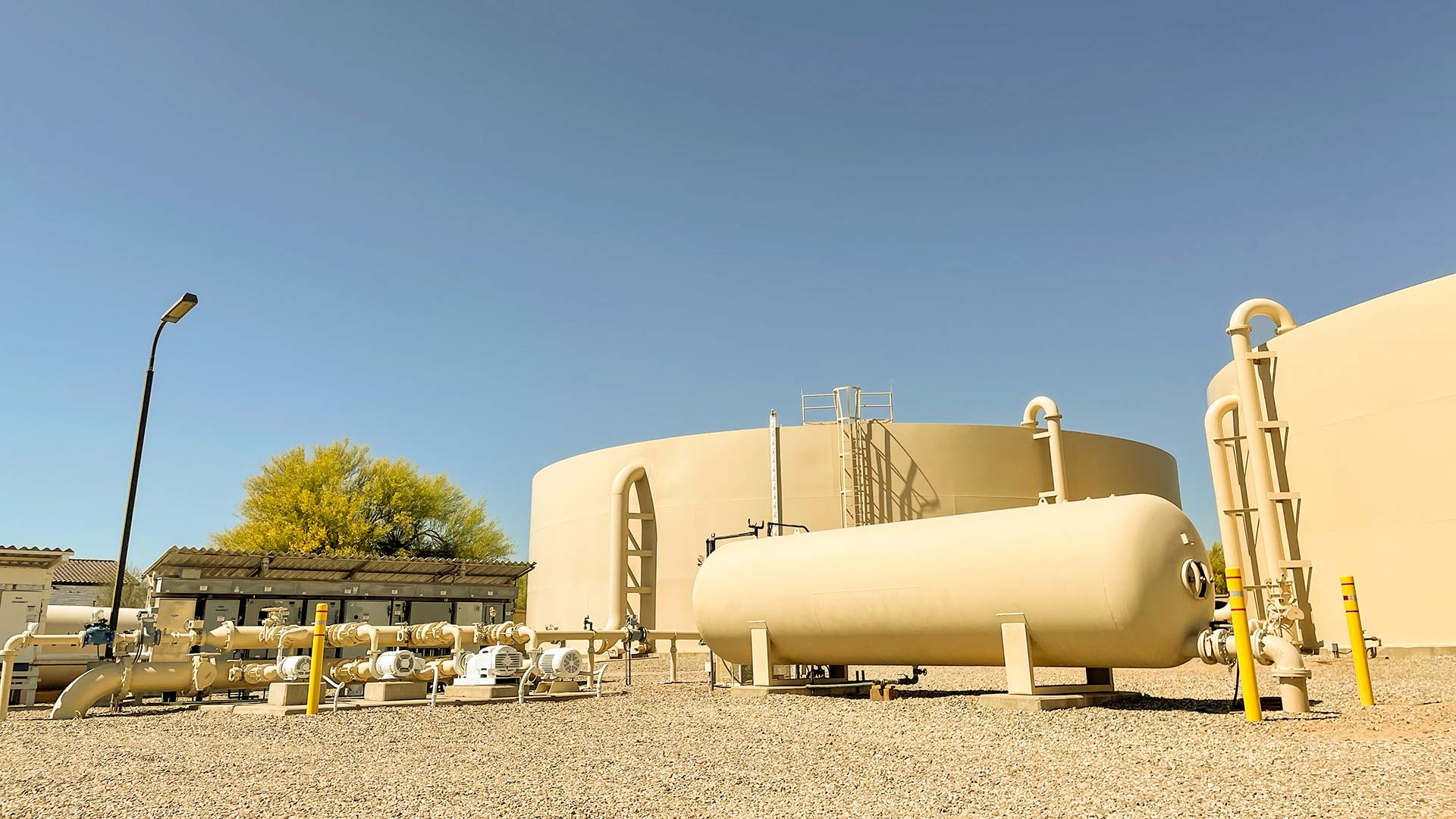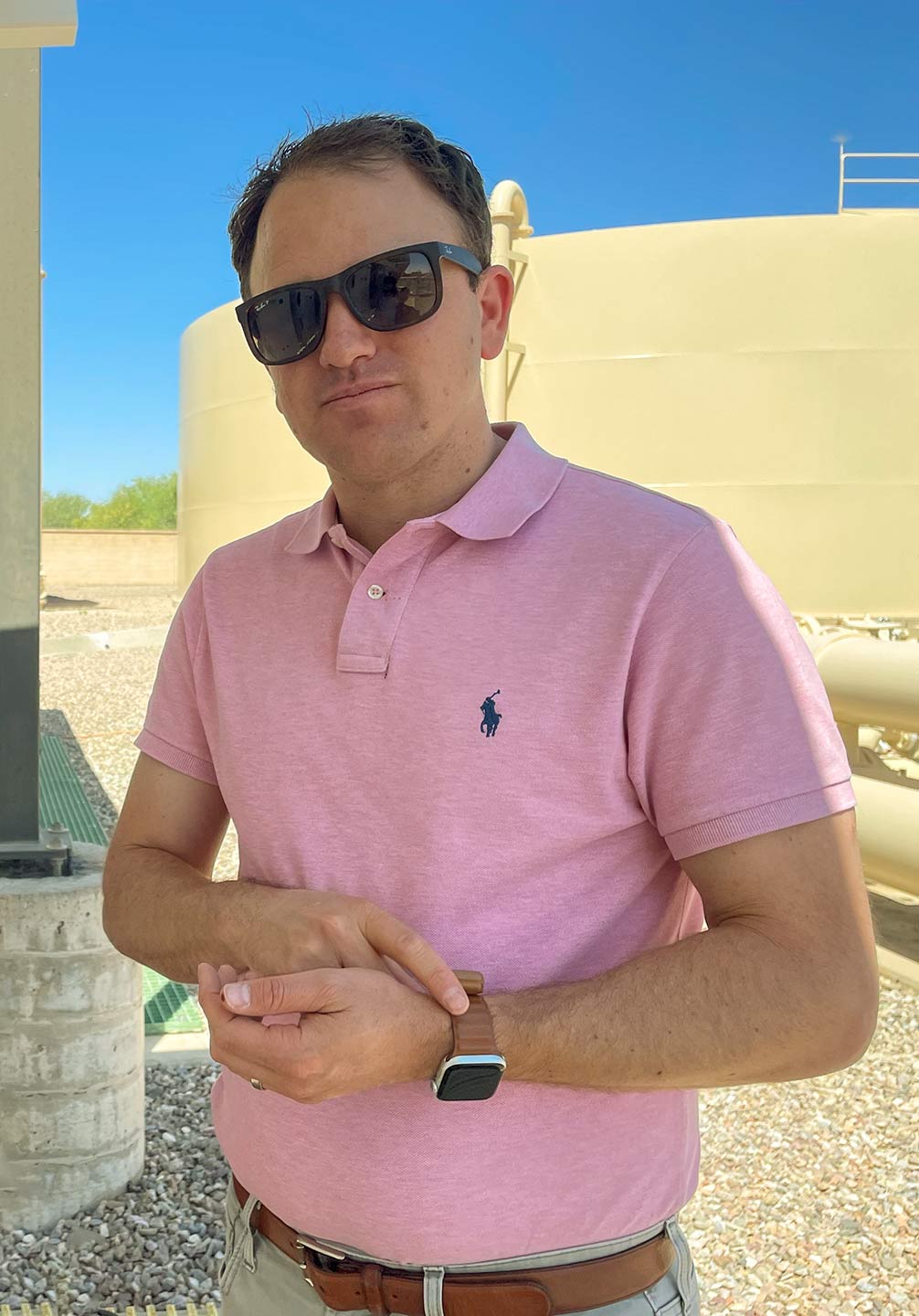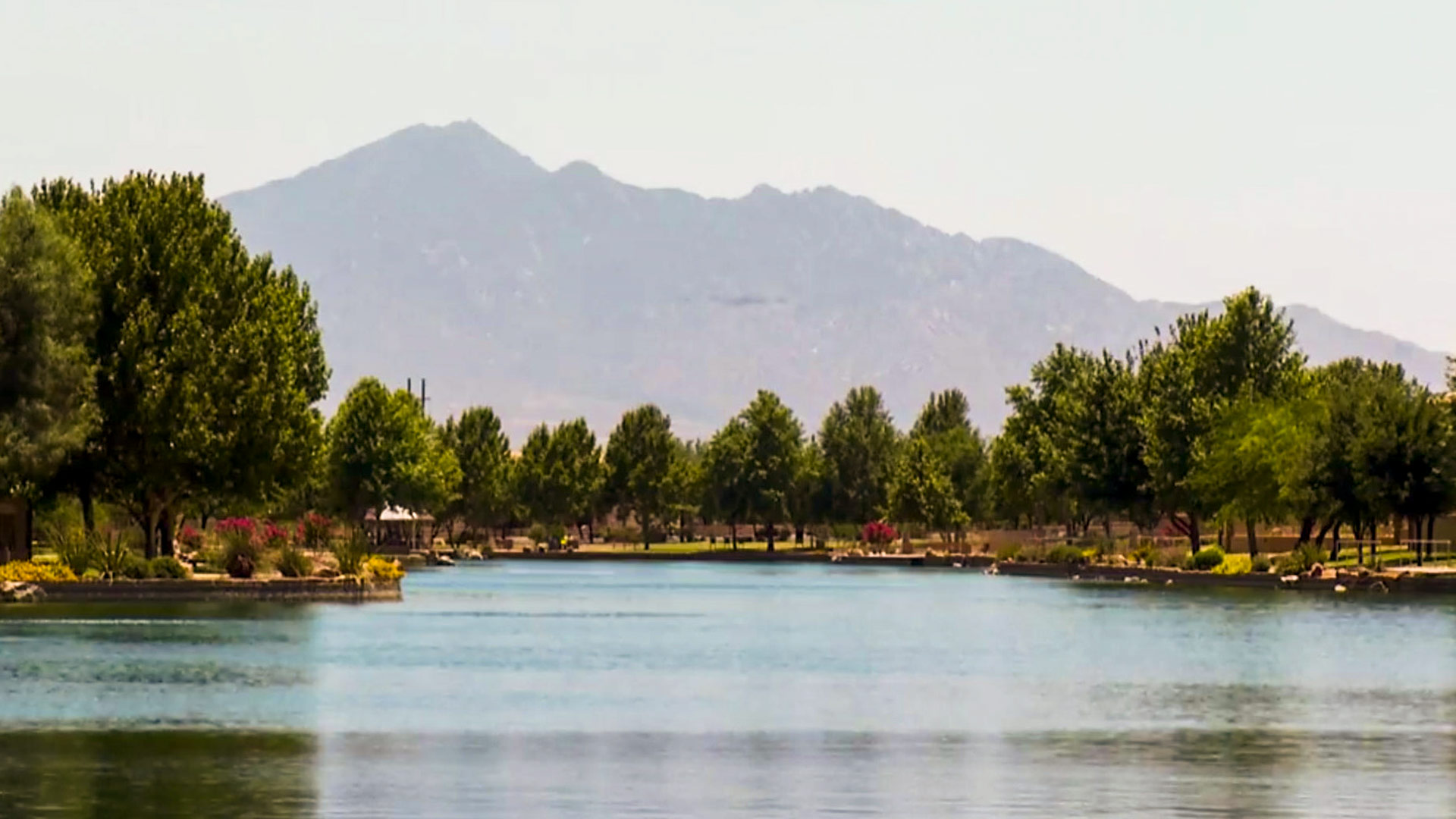 Rancho Sahuarita has grown fast, and its water utility has had to grow quickly with it.
Rancho Sahuarita has grown fast, and its water utility has had to grow quickly with it.
We should go where the water is

Jeremy Sharpe is a managing partner for Rancho Sahuarita, a housing development south of Tucson. He wants you to get out of the house more.
“Getting someone in a young family out of their house and going to a park, meeting another young family and building relationships, that is community,” Sharpe said.
He also thinks that when you go out into the world with other people and share space with them, that could save water.
At the same time, he doesn’t want to force anyone to get rid of their grass completely, though residents of Rancho Sahuarita aren’t allowed to have grass in their front yards.
“Yes, they could have grass in their backyard. Yes, they could have play equipment in their backyard, and a lot of our residents do. I have young kids, so I understand that. I have a swing in my backyard.
“But what we've tried to do is really position parks, position different amenities and green spaces and playgrounds and different types of amenities for kids throughout neighborhoods, so people don't feel the need to have that,” he said.
He said these are the kinds of things that Arizona developers who want to keep growing for a long time do.
Rancho Sahuarita is a development that sprung up about twenty years ago.
 VIEW LARGER Jeremy Sharpe is a managing partner for Rancho Sahuarita. He says he tries to encourage people to use less water by providing more communal spaces.
VIEW LARGER Jeremy Sharpe is a managing partner for Rancho Sahuarita. He says he tries to encourage people to use less water by providing more communal spaces. Sharpe said when his late father helped found the town of Sahuarita, there were only a few thousand people in the area. By 2010, it had grown to 25,000.
That’s in large part because of this development. Arizona was also going through a housing boom. The number of houses in the state went up by 30 percent between 2000 and 2010. It outpaced every state except Nevada.
Rancho Sahuarita is about 3,000 acres and has around 6,000 homes at the moment, but has entitlements to grow up to 11,000.
The median sale price for a house in Rancho Sahuarita today is $338,500. The price has gone up over 60 percent just in the last three years.
We wanted to be the most highly amenitized community in Southern Arizona,” Sharpe said.
It’s a master-planned community–a kind of housing that’s typically built around golf courses and club houses, and most things residents would want to do is right there. These really hit their stride at that time, in the 90s and aughts.
“So the vision was–how do you bring that country club lifestyle, that level of service, to that first time home buyer? That young family, the teachers, the Border Patrol, the Raytheon employees?” Sharpe said.
Sahuarita is completely reliant on groundwater. It’s also part of an Active Management Area, which means it has some of the most strict water regulation in the state. The town even has to prove at regular intervals that it knows where its next 100 years of water is coming from.
“In Arizona growth has to pay for itself, and so it's really on the developer to figure out how to get water, how to get sewer, how do you build the roads and the infrastructure,” Sharpe said. “Now there's some public financing options that allow it to be a little bit easier, but that takes some time.”
That rule–that developers need to prove their water supply is stable–has been around for a few decades.
Kathleen Ferris helped put that rule into place. She was the executive director for the Arizona Groundwater Management Study Commission in the 70s, and later led the Arizona Department of Water Resources. Now, she researches water policy at Arizona State University.
“We felt that it was negligent to think that we were going to be managing our groundwater supplies in these Active Management Areas and not require developers to demonstrate that they had the water supply needed,” Ferris said.
Groundwater is a finite source, so once it's used up, that’s it.
Ferris said she is concerned that the state is allocating every bit of usable groundwater in these districts, especially in the Phoenix and Pinal AMAs.
She also stressed that a lot has changed since these rules were put in place: climate change has ramped up, there’s a mega drought and the Southwest is becoming more arid. That puts a bigger strain on that finite source than they’d imagined.
“It was serious in 1980. It's much more serious today,” she said. “But I will say this, without the groundwater management act we'd be in far worse shape.”
The state checks in every 15 years and could come to the conclusion that there’s actually not as much water there as it thought before.
“For subdivisions that individually get a certificate of assured water supply, those are locked in. They’re never reevaluated,” Ferris said. “So if it's determined down the road that wait a minute, we're going to run out of water in 75 years, not 100 years. Well, those homeowners will bear the brunt of that.”
She said we shouldn’t be so reliant on groundwater and need to plan for leaner years ahead with the state’s allocation of Colorado River water.
“We should go where the water is, first of all,” she said.
Phoenix has a stable water supply, especially compared to raw desert land outside of it. And Ferris said that’s leading to more infill, which means the area is growing upwards.
“But at some point,” Ferris said, “well, how do you want to live? Do you want to live so meagerly when it comes to water, that it's not even a pleasant place to be anymore?”
I went to the Rancho Sahuarita water park with Jeremy Sharpe in April, which is early in the season.
There were little kids with their parents in a splash pool, but only a few because the park wasn’t in full swing yet.
“Our pools are open–our three pools are open all year round, but our water park opens Memorial Day through Labor Day,” Sharpe said.
In that window, this place gets packed.
“This big red bucket right here fills up with water, and then a big bell goes off. You'll see dozens of kids running to it and get water dumped on them,” Sharpe said. The water circulates through a filter system and comes back through the red bucket and onto the kids’ heads.
There were also slides, water cannons and tunnels. The development also has a lake where a visitor can stand on one end of and not even quite see the other end.
He said there’s no question people are going to use water like this. This is a place where temperatures hover around 100 degrees consistently in the summer.
He said the big question is, how do you give people perks like this in a responsible way?
“How we look at it is saying, ‘hey, if growth is going to occur, if people are going to live a lifestyle [where] they want pools, how are we able to provide that and maybe limit their usage, maybe limit their desire to have their own pool? Or limit their desire to have grass?”
That’s not the only way they try to limit water use. The homeowners association also limits what kind of trees and plants beyond grass residents can put in their yards to ones that do well in this climate. They’re working on updating meters, too, so they can catch leaks earlier.
Sharpe isn’t turning the industry on its head with the changes he’s making by any means. But he sees what’s coming down the road.
Grady Gammage Jr. is a real estate lawyer and a researcher at the Kyl Center for Water Policy at ASU, along with Ferris.
He wrote two reports about ten years apart, trying to predict how water will affect growth here in Arizona.
He wrote the reports to give a 1,000 foot view of the issue. Gammage said he has received criticism for lumping a lot together, but it’s also one of the few things published that talks about this issue on a broad scale.
“Whose water is it? Who controls it? Is it a county? Is it a city? Is it a Native American tribe? I lumped it all in one basket,” he said.
He wrote the report specifically about the most populated strip of Arizona, the stretch from the Phoenix metro area to the Tucson metro area.
“In 2011, I was pretty optimistic that if you looked at it in those terms, we probably had a robust enough water supply to get us out 50, 60, 70 years or more at the current rate of growth. I came back and did that again 10 years later, in 2021, and was less optimistic about how long we can go,” he said.
There were a lot of reasons for that, and one of the big ones is the decline of Colorado River water. He said that he underestimated how big those cuts would be, even in the 2021 report.
Gammage said ten years ago, he was also banking on the state moving more quickly on conservation.
“We're getting more efficient, but what happened is we harvested a lot of the low hanging fruit inside the house and even in landscaping, but we're not becoming more efficient as quickly as we were,” he said. “It's tending to plateau.”
That low-hanging fruit includes low-flow toilets, less turf and fewer pools.
At the same time, the major metro areas of Central to Southern Arizona together are growing by about 100,000 people a year, or a million each decade. Gammage says that at that rate, we’re only a few decades from hitting capacity with our water supply.
It also assumes the area eventually abandons agriculture, which is a really big if, even though agriculture uses significantly more water. And that everyone has equal access to water, which they don’t.
“The question of whether or not there's enough water to continue to support houses at the rate we're building them winds up being a relatively local question,” he said. “Are you building those houses in the city of Phoenix? Then you're probably in good shape. If you're building those houses in some of the smaller communities, not so much.”
Arizona is also growing fast, and he said it matters how people and companies who move in see this land.
He has spoken to people who’ve moved here from far corners of the country and says there are plenty who worry they’re going to wake up and no longer have water. That’s not likely to happen anytime soon for residents of metro areas with stable water supplies.
And then there are people who move here from much greener places, and try to bring the comforts of home with them.
“We think the West is this place where you can be a rugged individualist, and you can buy a plot of land and eke out a hardscrabble living all on your own. And it's absolute mythology. It is not true.
“You have to get along well enough with your neighbors to share some kind of plumbing system, a private system or municipal system. And municipal is the safest because it's the most people sharing,” Gammage said.
“The West has always been and has to continue to be a place built on collective action,” he continued. “But we've all internalized this notion that we hate the government and the West is the place to get away from the government. Well, no, it's just not.”
There are also big companies eyeing Arizona, and Gammage said they’re watching as water cuts happen here.
“Now, they're not like an individual person buying a house in Phoenix. They have sophisticated consultants. They can talk directly to the decision makers at the state on the local level about their water use and so on.
“Nevertheless, it's going to become more and more of an issue, as we begin to bump against limits for entities like that,” he said. “Well, if employers like that don't come here, then the people don't follow afterwards. And so I think it is going to manifest most acutely with regard to jobs and economic development quicker than it will with regard to housing.”
He also said that Governor Doug Ducey’s recent investment in water infrastructure is like throwing $1 billion at a $10, possibly $15 billion problem.
“It's going to take a lot of money to solve Arizona's long term water supply, I can comfortably tell you. I think we can go 20 or 30 years based on our current water supply with growth,” he said. “But that isn't a good enough answer anymore because somebody like TSMC or Intel, they're making $100 million, billion dollar investments. 30 years isn't good enough.”
Pinal County is at the heart of this discussion. It’s a rural county, mostly between Phoenix and Tucson. Milk and cotton are big businesses there. It ranks high among U.S. counties for cotton and milk production, and grows a great deal of alfalfa for those cows. It also grows a lot of pecans.
Stephen Miller serves on the Pinal County Board of Supervisors. He said that those crops get a lot more than water from being here, similar to what we saw in Yuma a few episodes back.
“We have to be smart about how we use our land,” he said. “I mean, you wouldn't take perfectly good farmland and put a factory on it.”
There is also a lot of development. Miller said that he really started to get concerned about water here about ten years ago.
“It was the feeding frenzy of the people buying land speculating on land, for development going forward. And when somebody would purchase 160 acres, they're looking at putting, you know, 3000 homes on it,” he said.
Growth was moving really fast, and local governments struggled to keep up, from the fire department to the sewage system to the water supply.
“What's the word I'm looking for? It's…it's kind of intimidating,” he said.
Then, earlier this year, the Lower Colorado River Basin made its first cuts. And because Pinal County had been late to the game in getting access to that water through the Central Arizona Project, it was one of the hardest hit.
“The agricultural community has enjoyed some good times because of the CAP,” he said. “In this area, and I'm speaking for the most part of the Pinal AMA area, the water consumption by these farmers over the last two decades has been somewhere close to 60% CAP water.
“They didn't have to drill or pump very much, and that was a benefit, not only to them, but to everybody as a whole. Because the CAP water was actually recharging our aquifer.”
That meant the aquifer was also being recharged.
But now, that puts pressure on farmers. Putting in new wells and digging deeper ones costs a lot of money. At some point, it probably won’t be worth it.
“That's the day that the farmer probably says, okay, it's time to sell the farm and turn it into houses. That is going to be a transition. I just think that transition needs to be as far out as possible,” Miller said.
He thinks technology can push that out further still, but eventually, more and more Pinal County farms are going to turn into houses.
“I think we're pretty close to whether or not the state is going to continue to allow certificates of assured water,” he said.
Miller said there’s not much more water to promise to developers, but that’s not a concern yet. There are about 100,000 lots approved for housing. But if the state wants to continue the levels of growth it’s seen over the past few decades, it’s going to run into a problem eventually.
“Will there be a need and the desire to continue to get certificates of assured water? I'm sure there will be because not all the land that has been speculated for rooftop growth in the future will be desirable or probably be economically feasible to develop,” Miller said.
 VIEW LARGER A view of the Santa Rita mountains from Rancho Sahuarita Lake.
VIEW LARGER A view of the Santa Rita mountains from Rancho Sahuarita Lake. Back in Rancho Sahuarita, Jeremy Sharpe said this place is still booming. Growth of all kinds is happening.
He was concerned about developments around Rancho Sahuarita going up, and about nearby pecan farms, which is also big business in his corner of Arizona.
“Pecans are very thirsty. They flood irrigate, and so they use tremendously more water than what we use, and what a household uses. It's something that I think about,” Sharpe said.
He doesn’t expect that growth to slow down anytime soon.
“That's going to be a challenge for our industry, not only developers in our region, but also the community as a whole,” Sharpe said. “Because if you can't plan for growth in a strategic way, it's just going to happen.”
He said if the state isn’t intentional and strategic about the way it plans for growth, that growth will happen on its own, and we’ll all be dealing with the consequences.





By submitting your comments, you hereby give AZPM the right to post your comments and potentially use them in any other form of media operated by this institution.